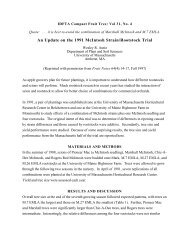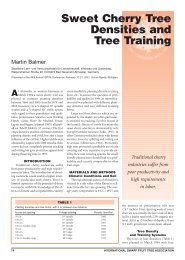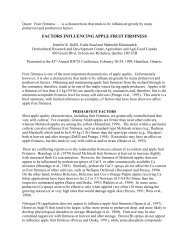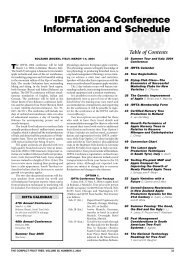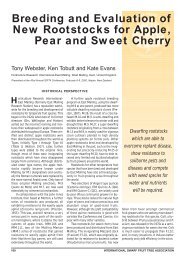Management of High Density Pear Orchards - Virtual Orchard
Management of High Density Pear Orchards - Virtual Orchard
Management of High Density Pear Orchards - Virtual Orchard
- No tags were found...
You also want an ePaper? Increase the reach of your titles
YUMPU automatically turns print PDFs into web optimized ePapers that Google loves.
in the tree and that the apical dominancefrom these terminal shoots controls theother growth reactions on the same branch.The productivity in this V-hedge system isbased on flower buds on short spurs and onbourse shoots on the four central leaders.The planting distance in the V-hedgesystem is 3.5 x 1.25 m (11.5 x 4.1 ft) whichmeans 2057 trees/ha (833 trees/acre). Theopening <strong>of</strong> the V is 1.4 m (4.59 ft) at 2 m(6.56 ft) height. There are more intensiveV-planting systems with 3.2 x 0.8 m (10.5 x2.62 ft) planting distance with 3516 trees/ha(1423 trees/acre) and with a more narrowopening <strong>of</strong> 1.2 m (3.94 ft). Under our climatologicalcircumstances it is difficult toallow sufficient light penetration in thesemore intensive V-hedges so flower bud formationis more variable in the intensive V-hedge systems. A disadvantage <strong>of</strong> this V-hedge system is the high amount <strong>of</strong> laborwhich is necessary.Tiense Hedge SystemIn this system we start with 2-year-oldtrees on Quince Adams rootstock also withat least four equally developed feathers onone stem. Two feathers are placed at plantingin the row direction and attached on awire. The two other feathers are placedperpendicular to the row direction andshould help to bring the trees into earlyfertility. The central leader is pruned backto about 70 cm (27 inches) above the lowestscaffold branches and the narrow angledgrowth reactions to that pruning cutare used to form the second level <strong>of</strong> scaffoldbranches. This operation is repeatedfor level three and four <strong>of</strong> the scaffoldbranches. Only two scaffold branches arekept on each level and they are bound ontothe wire structure. The fruit is hangingpredominantly on the short fruiting spurson these limbs and these structures are renewedby pruning them once they getolder. The top <strong>of</strong> the tree is composed <strong>of</strong>the last two scaffold branches. The plantingdistance in this hedge system is 3.5 x 1.75 m(11.5 x 5.7 ft) which means 1632 trees/ha(661 trees/acre).TABLE 1Flower bud quality on young Conference pear trees.Free Spindle SystemIn this system we also start with 2-yearoldtrees on Quince Adams rootstock withmany well-developed feathers. At plantingthe number <strong>of</strong> laterals is limited to tw<strong>of</strong>eathers in the direction <strong>of</strong> the row whichare chosen with a distance <strong>of</strong> about 15 cm(5.91 inches) on the central leader. Thesetwo laterals are tied to an angle <strong>of</strong> about45˚. The central leader as well as the twolaterals is left unpruned. At the end <strong>of</strong> theunpruned central leader, competing lateralswill develop and they have to be removedin a very early stage at a length <strong>of</strong> about10 cm (4 inches).The many flower buds on the centralleader and on the laterals result in earlyproductivity and also in a good start forhorizontal branches starting from thebourse shoot. The first growth reaction onthese flower buds will be a short bourseshoot <strong>of</strong> 10 to 15 cm (4-6 inches) endingon a flower bud. The next year this shortbrindle shoot will develop to a long shoot<strong>of</strong> more than 50 cm (19.7 inches). And inthe third year this long shoot will be coveredagain with short brindle shoots.This sequence <strong>of</strong> short–long–shortshoots on the central leader is very importantfor the free spindle training system.The fruit bearing wood is systematically renewedas much as possible by keepingstrong 1-year-old shoots that are coveredwith flower buds in the second year andwill bear fruit during the third year.When the trees are in a good balancebetween vegetative and generative growththere will be part <strong>of</strong> the flower buds on the2-year-old wood in lateral position. Theseflower buds are later in phenological developmentwhich is an important factorwhen frost damage occurs. The productivity<strong>of</strong> the trees in the free spindle system ismainly on the short brindle shoots on the2-year-old wood and on spurs on thebourse structures. In this training systemthe fertility <strong>of</strong> the flower buds on the 2-year-old wood is important. Conservation<strong>of</strong> some upgrowing new growing shootsleads to differences in branch diameter andindicates the way <strong>of</strong> natural growth <strong>of</strong> the# flower clusters/fruiting branch # flowers/cluster1998 1999 2000 1998 1999 2000on 2-year-old wood 8.10 4.15 9.63 6.29 4.91 6.05on 1-year-old woodin lateral position 7.05 1.85 1.12 7.25 6.68 3.23in terminal position 0.95 0.85 0.19 11.99 9.75 5.13fruit tree. These differences in twig diameterare more accentuated during the seasonby the natural bending tendency <strong>of</strong> thetwigs under the weight <strong>of</strong> the leaves on the1-year-old shoots and under the weight <strong>of</strong>the fruits in terminal position on the fruitbearing twigs.The planting distance in this system is3.75 x 1.5 m (12.3 x 4.9 ft) which means1777 trees/ha (719 trees/acre). An advantage<strong>of</strong> this system is the relatively lowamount <strong>of</strong> labor needed for training andpruning.FLOWER BUD QUALITYThere are important differences inflower bud quality on pear trees. The bestflower bud quality on pear trees can befound on the terminal flower buds on theshort brindle shoots (Table 1).The highest number <strong>of</strong> flowers percluster was found on the flower clusters interminal position on the 1-year-old woodwith more than 10 flowers per cluster. Thenumber <strong>of</strong> flowers per branch can varyconsiderably between years when countedon comparable places in the tree. Sometimesthe crop load can explain these differencesbut sometimes there are other determiningfactors such as climatologicalfactors. For the flower buds on the 1-yearoldwood the growth situation on theshoots has an important influence: late regrowthreactions during season can bevery negative for flower bud formation onthe 1-year-old wood.The number <strong>of</strong> flowers per cluster is animportant parameter <strong>of</strong> flower bud quality.The highest number <strong>of</strong> flowers per clustercan be found on the terminal buds <strong>of</strong>the short brindle shoots. In some years thenumber <strong>of</strong> flowers on this place varies between10 and 15 flowers per cluster whilethe flower buds on the 2-year-old woodhave only 5 to 7 flowers per bud.The number <strong>of</strong> leaves is also an importantflower bud quality criterion. Flowerbuds without leaves have a very low fruitset capacity; they occur on the 1-year-oldshoots with late regrowth reactions; thereis apparently a competition between thisregrowth and the flower bud formation.The presence <strong>of</strong> a bourse shoot at the base<strong>of</strong> a flower cluster significantly increasesthe leaf area <strong>of</strong> a flower cluster. Theseleaves around the flowers increase the fruitset capacity <strong>of</strong> the cluster.The total weight <strong>of</strong> a flower bud alsocan be a good indication for flower budquality and can be determined on differentphenological stages.Internal flower bud quality criteria alsoexist. The number <strong>of</strong> seeds per fruit is118 INTERNATIONAL DWARF FRUIT TREE ASSOCIATION



